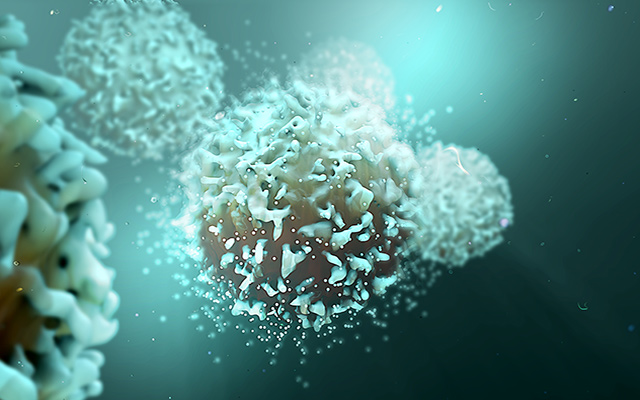Up until recently, most of the focus for safeguarding us from COVID-19 has been on the neutralizing antibody proteins (NAbs) created by our immune systems in response to an attack by the virus. Antibodies are produced by B cells, one of two types of protective lymphocytes among the white blood cells, explains infectious-disease researcher Daniel Altmann, PhD, a professor of immunology at London’s Imperial College.
“B cells work by making antibodies, the soluble molecules that bind and mop up pathogens before they can gain entry and do damage,” he says.
Antibodies work quickly — plus they’re measurable with a simple blood test — yet recent research has found some worrying holes in how antibodies work against COVID-19.
First, there have been widespread cases of people who have recovered from the novel coronavirus SARS-CoV-2 (which brings on COVID-19) and then had serology tests to assess antibodies in their blood — only to discover they have no antibodies, or not enough to register on the tests. A study still under peer review from Shanghai Public Health Clinical Center and Shanghai’s Fudan University found that as many as 30 percent of the 175 patients who had recuperated from the viral infection showed a “very low level” of COVID-19-specific antibodies and nearly 6 percent seemed to have no antibodies at all, reports study coauthor Fan Wu, PhD.
But there’s another wrinkle: COVID-19 antibody tests can be faulty too. The newly developed tests are not fully refined or accurate yet, and with a low prevalence of the population actually having COVID-19 antibodies, even the best test will show more false results, according to infectious-disease expert Michael Osterholm, PhD, MPH, director of the University of Minnesota’s Center for Infectious Disease Research and Policy.
This does not necessarily mean that the COVID-19 survivors never had those hard-won antibodies: They may have had them, but the antibodies appear to wane — and in a discouragingly short time, sometimes in as little as eight to 10 weeks, according to Altmann.
And this has raised the scary scenario that you could fight off COVID-19 only to contract it again. And again.
So if antibodies aren’t our chief defense against the virus, what else could be helping to protect us?
A wealth of new studies are identifying cells within our immune systems that may be the actual heroes: T cells. T cells are the second type of protective lymphocytes besides B cells, and thanks to our past exposure to common colds caused by other coronaviruses, they may have helped build our immunity to the novel COVID-19 — perhaps more than previously thought.
Plus, this emerging understanding of the T cells’ role might lead the way to a more rapid development of an effective vaccine.
The Power of Your Immune System
“T cells perform two key roles,” Altmann explains, “helping activation of B cells [which produce antibodies] and killing any cells that have become infected to eliminate infection.”
There are several types of T cells working together like a microscopic emergency-response team within your body: So-called helper T cells (technically known as CD4+ T cells) seek out infecting antigens and work like 911 dispatchers who direct the killer T cells (CD8+ T cells) to do the dirty work of ridding your body of unwanted invaders.
A small study released in June 2020 and published in the journal Cell examined how T cells respond to COVID-19. In a study of 40 people — half infected with COVID-19 and half uninfected — scientists tested T cells in people who had survived mild-to-moderate infections of the virus and in people who were uninfected.
The results were startling.
While 90 percent of the survivors showed coronavirus antibodies, 70 percent displayed COVID-19-specific helper T cells and 100 percent had similar killer T cells. “We found that they developed a robust immune response including T cells,” explains study leader Alessandro Sette, Dr. Biol.Sci., professor at La Jolla Institute for Immunology’s Infectious Disease and Vaccine Center. “This finding is important because at the time there was some uncertainty whether the immune system can mount a substantial and lasting immune response and our study laid that fear to rest.”
The real surprise was yet to come though: Half of the unexposed people were also found to have COVID-19-specific T cells protecting them. The kicker? These control-group blood samples had been collected between 2015 and 2018 — well before COVID-19 even appeared on the world stage.
Although these individuals couldn’t have previously been exposed to SARS-CoV-2, Sette’s team found they had helper T cells that could protect them against at least three of the four common-cold coronaviruses.
“We further speculated that these T cells may potentially reduce COVID-19 disease severity, based on things we know about flu and T cells,” he says. “Even if antibodies levels decrease after people have recovered from COVID-19 or after receiving a vaccine, it doesn’t mean that they no longer have any protective immunity.”
Sette refers to these T cells as “cross-reactive” because they can react to several types of the coronavirus. And he also terms them “memory” T cells, because they keep a cellular record of past infections.
“Memory helper T cells remember the virus when it makes a reappearance and jumpstart the antibody response during subsequent infections, giving the immune system a running start over the virus. Memory killer T cells can find and destroy virus-infected cells, interrupting the virus’s spread,” he explains.
Other new research is corroborating the T-cell findings, including a similar Oxford University study still under peer review. And research published in Cell in August 2020 from Sweden’s Karolinska Institutet and Karolinska University Hospital found that people with mild and even asymptomatic COVID-19 had developed the defensive T cells, even if they didn’t test positive for antibodies.
A side effect of this research is that thanks to T cells, public immunity to COVID-19 may be higher than antibody tests suggest. Much higher, says study coauthor Hans-Gustaf Ljunggren, MD, PhD, professor at Karolinska’s Center for Infectious Medicine. “Our results indicate that public immunity to COVID-19 is probably significantly higher than antibody tests have suggested. If this is the case, it is of course very good news from a public-health perspective.”
But there’s still a wrinkle to this newfound hope, explains Sette. In a study published in Science in August 2020, Sette’s team discovered that past exposures to common-cold coronaviruses can teach your immune system to recognize SARS-CoV-2 — which may give some people a head start in fighting off COVID-19 or result in only mild symptoms, while others get severely sick.
“What we don’t know yet,” he cautions, “is whether cellular immunity will be enough to get rid of SARS-CoV-2 permanently.”
Your Immune System’s Long Memory
As this new research is demonstrating yet again, the body’s immune system relies on more than one defense. Both B-cell–produced antibodies and T cells help protect us. As Columbia University immunologist Donna Farber, PhD, has explained, the different parts of our immune system work together like the multiple branches of the armed services — army, navy, and air force. One branch might stand down while another performs a specific duty, or they might join forces to create a full-on assault.
And as this research is also demonstrating again, different viruses and diseases attack our immune system in different ways. The MERS-CoV coronavirus that causes Middle East Respiratory Syndrome (MERS) directly targets and destroys T cells. The human immunodeficiency virus (HIV) not only assails helper T cells, it short-circuits the immunity cells into replicating the virus; the destruction of the immune system itself leads to AIDS (acquired immune deficiency syndrome). In some cases, COVID-19 can make the immune system go haywire and simultaneously attack multiple healthy organs and tissues.
It was past research on the original SARS-CoV-1 virus causing severe acute respiratory syndrome (SARS) that found that antibodies there also waned and yet some immune cells remained that recognized the virus. This background information helped focus the current studies.
Although COVID-19 antibodies appear to wane, the cross-reactive memory T cells have a strong advantage: Like an elephant, they boast a long memory.
“Once the acute response [when the immune system fights off the immediate threat] has finished, both the B cells and T cells sink back into memory [mode],” explains Altmann. “This is a state where they’re more ready to act more quickly and potently next time.”
Better yet, these new studies “seem to indicate ‘immune memory’ lasting for decades,” he says. And specifically, a paper published in Nature in July 2020 looked at T-cell memory in people who had recovered from SARS after the outbreak in 2003–2004 and discovered it was cross-reactive with SARS-CoV-2, so could help fight it off based on past viral infections. “They found it to be detectable and strong” — 17 years later.
There’s one big issue with T cells, though. Although testing for antibodies is relatively quick and easy (if problematic), testing to see if your T cells have cross-reactive memory of viruses requires complex and expensive laboratory work. It likely won’t be available at drive-throughs anytime soon.
Still, understanding the immune response to COVID-19 may point the way to quicker vaccine development.
Creating a COVID-19 Vaccine
“It will take at least a year to a year and a half to have a vaccine we can use,” National Institute of Allergy and Infectious Diseases (NIAID) director Anthony Fauci, MD, told U.S. senators in March 2020. That seems an eternity in the midst of the COVID-19 pandemic, but if Fauci’s prediction comes true, it would actually be a record for vaccine development. The fastest-ever vaccine was created to combat mumps: It required more than four years.
That lengthy timeframe is due to several factors. First, a candidate vaccine must be developed. Then, three phases of clinical trials are run to make sure that the vaccine is safe and that it does its job. Next, the U.S. Food and Drug Administration has to review the data and decide whether it approves the vaccine.
Altmann and Sette are optimistic the latest findings will help direct — and, hopefully, speed — vaccine development.
“When the immune system responds . . . there are potentially thousands of interacting types of white blood cells and molecules in that response,” Altmann explains.
“The precise nature of protective immunity to COVID is still largely uncharted,” he continues. “We need to know about far more than just who has antibodies. . . .
“At its simplest, this may be a particular level of spike antibodies or a particular frequency in the blood of specific T cells. Nobody really knows these values, but they’re rather important if we’re to have a rational, data-based evaluation of which vaccines we most favor. You wouldn’t invest in a new car without having some way of measuring and comparing them for things like acceleration, fuel consumption, etc., so why would you launch into a choice of vaccine to save the planet on a ‘first past the post, warp speed’ basis without any comparison of hard data?”




This Post Has 0 Comments